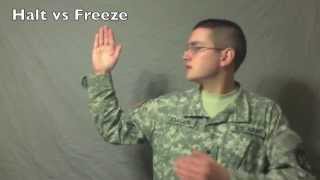A general pet peeve of mine is when an author or film maker attempts to depict military action, or a military milleu, and obviously lacks the knowledge to do it right.
One specific annoyance in the last decade or more is the hand-arm signals used by actors portraying fighting men.
(Such signals are used by marines and infantry while moving tactically in the field, prior to contact, lest they break noise discipline by talking.)
Now, granted: units down to the platoon level often develop their own S.O.P.s for signaling, but in my experience the basic set of signals (get in the wedge; move out; double-time; cease-fire; rally point; head count; halt; freeze; enemy sighted; etc.) are universal across the combat arms in both the US Army and USMC.
So here’s what I think happened: Some movie was made depicting soldiers or marines on a patrol or some other tactical movement. The point man heard or saw something to make him suspect the enemy was close, so he gave the signal to “freeze.” The grunts stopped in their tracks. Some other film maker watched the scene and decided, “Hey, that’s kinda’ cool. Now I know everything I need to know about tactical movement.”
So that film maker, when it was his turn to display his wealth of military research, had an actor use the gesture when it was his turn to film such a scene. Problem is, he thought it was the symbol for “halt,” (open palm facing the troops: “Come to a stop, you richard-heads.”) which is used in different circumstances than “freeze” (raised fist: “Don’t make a move or you might get all our asses shot off!”)
After that, any time a similar scene was shot in any subsequent military movie, rather than hire an advisor to police basic minutia like this, the director went by how it was done in the last flick. After all, “it looked cool.”
So now, invariably, the “freeze” signal is used to command a halt on the screen (even in non-tactical situations, and even in vehicle convoys).
The fallacy is so ubiquitous that I wouldn’t be surprised if actual soldiers begin jacking up the S.O.P. in a life-imitates-art manner after having grown up on these poorly researched movies.
[End of rant.]


There’s much more to it than that. There’s also the totally inappropriate use of arm and hand signals for the armed service and/or era portrayed. We often see modern day signals being used in WWII movies and that includes the use of SWAT signals. I think Dale Dye is responsible for some of this. I very much respect Dye as a military advisor as having set the standard for movie military advisors, but I have seen some minor Marine and Vietnam-era aspects (including arm and hand signals) incorporated into WWII movies and these have shown up in other movies.
I think the signals used in my day were standardized during or after Vietnam. So yeah, when I see them used in period pieces like Saving Private Ryan, it makes me go, “Hmm.” (There’s a lot more serious technical mistakes in that one, though, so I never raised a stink. Overall I enjoyed it, despite the inaccuracies.)
Dale did indeed raise the bar for tech advisors. But nobody knows it all and even he makes mistakes, like unit patches on short sleeve shirts in Forrest Gump.
But before Dale the errors came thick and fast. I remember a rumor in the service that it was actually illegal for an actor to wear the correct uniform, as that would be impersonating an agent of the USG. Guys believed that because they had NEVER seen an actor in the correct uniform. It’s still unusual to see a GI haircut or a beret worn right.
You would think, now that every swinging richard in the US Army is given a beret, there would be a WHOLE LOT of individuals who know how to shape it right. Still, in the movies it still always looks like a pizza hat. (It looks like they neither shave it, nor cut the liner out.)
My favorite signal is still the classic salute. So much respect in that. Thanks for the great read!
What about the oft-used finger pointing up, fast circle and point to the ground, directed to the soldier at the leaders side. Said solider then goes off to compile a ‘sitrep’ – is there any substance to this hand signal? As I’ve seen it in dozens of movies.
Hi David–thanks for the question. In every unit I served in, the S.O.P. was that that signal was used to designate a rally point. In other words: after the objective was accomplished (or if the mission went sideways beforehand), the unit would fall back to the RP thus designated. There we would get a head count, perform an ammo check, perhaps adjust the mission, etc. (Sometimes the circling motion was with the whole hand instead of just the index finger.) I haven’t caught this one in movies, but it sounds like another misportrayal.
Great post, i agree with Isaac that the classic salute is still up there among the best.